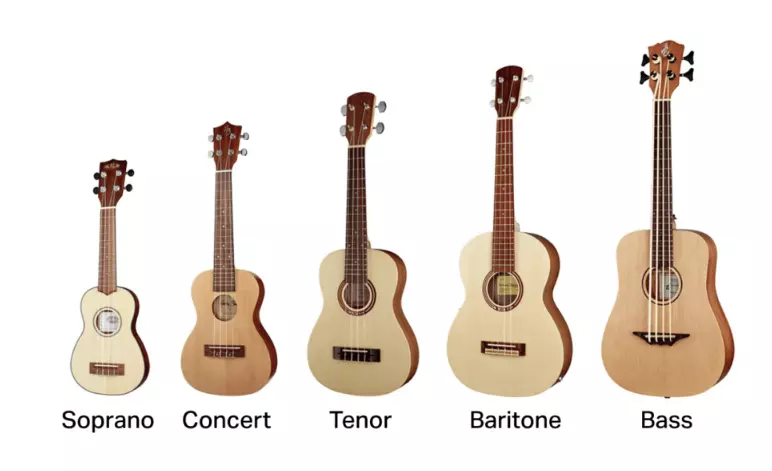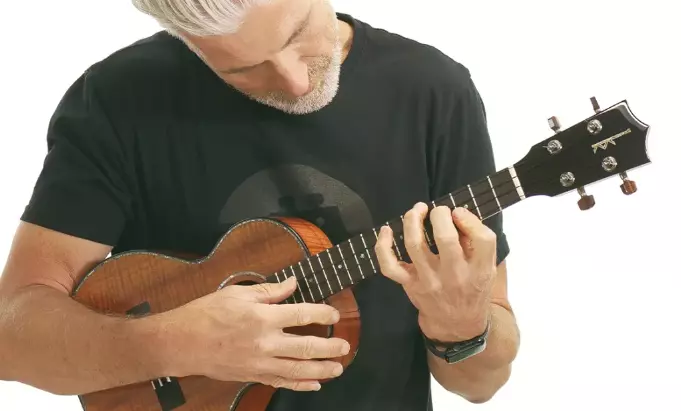The ukulele is a compact instrument with far more depth and nuance that meets the eye. It has many similarities with other stringed instruments like guitar, but that does not mean they are handled or positioned the same during play.
While a guitar’s size and shape naturally fits a player’s body when on a strap or resting on their thigh, a ukulele is much smaller and thus requires you to hold it in your hands, rather than bracing it against your body.
Additionally, there are several different sizes of ukuleles that can also affect how the instrument is supposed to be held.
This guide will teach you just how to hold, and play, a ukulele in all of its sizes and types.
Table Of Contents
The Different Ukulele Sizes

Credit: Yousician
As you can see in the image above, there are five distinct ukulele sizes. Our Ukulele Buying Guide goes in depth in the different sizes and materials of the ukulele.
Tenor and soprano are the most common sizes.
A tenor’s fingerboard length, as well as its mid-range tone, allows the player the widest range of ukulele music in terms of genre and difficulty. The soprano ukulele’s compact size and shorter fingerboard are helpful for beginners.
While soprano and concert ukuleles are slightly easier for beginners (and those with smaller hands), tenor ukuleles are what advanced players typically use.
That said, apart from the bass ukulele, all the other sizes are held and played in a similar fashion, though there are minor differences between some. Bass ukuleles use a strap and are played and held like miniature electric basses.
Where To Position A Ukulele On Your Body

In the image above, we see the player holding the ukulele in the center of her chest. It does not have to be exactly where she is holding it, as everybody is different, but it should be somewhere on your chest. Holding it too close to your belly will result in poor playing form and perhaps even injury.
It is perfectly acceptable and common to use a strap, as it will secure your ukulele better and free up your arms more. Many players opt for the traditional style, as the player is in the image above. She cradles the bottom of the ukulele with her right forearm, pinning it to her chest while she plays.
While you will need to change your forearm position depending on your instrument’s size, all ukuleles are held against the chest during play in this manner, securing it with either a strap or your forearm.
When holding a soprano, your forearm should be pinned against the far-right edge of the ukulele. With a tenor, your forearm should be higher up towards the corner.
The Appropriate Hand Positions For Ukulele Playing
While your right forearm is used to hold your ukulele (unless you have a strap), your right hand is also known as your strumming hand. You’ll know your hand is in the correct position when your fingers can comfortably reach the point where the fretboard meets the ukulele’s body.
Your left hand, or your fretting hand, is a bit trickier.
This hand supports the neck of the ukulele, and it should be held so that the fretboard is parallel with the ground. The neck should be resting on the base of your index finger, with your thumb pressing against the back of the fingerboard and your four other fingers resting on the strings, like in the image below.

Credit: Uke Like The Pros
While playing, your left fingers should be parallel with the frets and your thumb should be pressing against the back of the neck for support.
The player above is holding the neck with his wrist relaxed and in line with his arm, not bent awkwardly. Your fingers should naturally curl around the strings if you are holding the ukulele properly, giving you easy access to the fingerboard.
Additionally, having trimmed fingernails will make a world of difference for a beginner. As you can’t press with your nails, you can’t rest the tops of your fingers atop the strings and thus will have to change the positioning of your hands to compensate, which should always be avoided.
How To Play Ukulele Left-Handed
While all of our instructions so far have been in the context of right-handers, there are many lefties who play the instrument. Left-handed people have several options at their disposal when it comes to picking up the ukulele.
Unfortunately, ukuleles built specifically for lefties are extremely rare, so the options we will discuss will be with a standard ukulele.
1. Play it right-handed
Sadly, the most common solution is to simply play the ukulele right-handed. Pick up the instrument and hold it. Strum with your right hand and fret with your left and see if it feels comfortable. If so, then practice with that technique.
2. Flip it
If strumming with your right hand simply isn’t comfortable, then your next bet would be flipping the instrument 180 degrees so that your right hand is holding the neck and you are strumming with your left.
With it flipped upside down, you will have to learn all of your music upside down as well since the order of the strings is now reversed.
3. Flip it and restring
This is the final option because it is the most time-consuming. If you like the feel of playing your ukulele lefty but want your fingerboard to be the same as a standard one, then you will have to take your strings off and replace them with strings in the opposite order.
Although he wasn’t known for his ukulele playing, Jimmy Hendrix was famous for taking a right-handed guitar and restringing it opposite to play lefty.
When Holding A Ukulele You Should:
- Keep your hands relaxed.
- Hold your thumb on the back of the neck.
- Have your fingers lined up so they are parallel to the frets.
- Keep your instrument tight and secure to your chest.
When Holding A Ukulele You Shouldn’t:
- Allow your instrument to slide too low on your body.
- Squeeze the ukulele uncomfortably tight.
- Let your elbow stick out, or be too pinned against your body. Find a happy medium.
FAQ
Is it mor or less common to play ukulele with a strap?
Interestingly enough, the strap vs. strapless demographics are roughly even, with both options being extremely common. The use of a strap comes down purely to the preference of its player. The only way to know which you prefer is to try one out for yourself. Luckily, they aren’t very expensive.
Do these techniques change if the ukulele is electric?
No, as most electric ukuleles are just acoustic ukuleles with pickups in them, the way they are held does not change.
However, solid body ukuleles have bodies that are miniature electric guitars, so these will need to be played with a strap. Solid body ukuleles are uncommon and relatively niche.
Do ukuleles often come with a strap?
Sometimes a ukulele bundle will include a strap with your purchase, but overall it is uncommon for your ukulele to have a strap included. It is far more likely to come with a gig bag or clip-on tuner than a strap.


